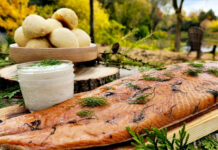
Severe food allergies are becoming more prevalent, with more than 200,000 people each year being sent to the emergency room, according to the Asthma and Allergy Foundation of America.
For attendees with severe allergies, it’s a hidden handicap that can really make them question whether or not to attend a several-day meeting for fear their dietary needs won’t be met, especially when traveling to a foreign country. To prevent these fears—and a potential attendee trip to the ER—meeting planners need to be extra diligent about how they collect allergy information as well as how they relay that information to the food and beverage team in charge of all snack breaks and meals.
You never know what surprising ingredient could be lurking in marinades or salad dressings—rice wine or soy sauce, for instance—and how much it can affect an attendee with an allergy setback. So, here are five important tips on how to prepare F&B menus with food allergies in mind.
Ask Questions in Advance
During registration, ask questions about dietary restrictions and make sure your questions are clear enough so that an attendee can share whether they’re describing a personal preference or a severe allergy, especially if they’re choosing from a drop-down menu. If you have an attendee with a severe allergy, make sure to read up on the different dietary restrictions and then follow-up with the attendee to see if they have specific suggestions on how to accommodate them.
Communicate with the F&B Team
The F&B team needs to understand the severity of the situation as well, especially if it requires using different equipment to make the food or even display the food. For instance, someone with a severe bad peanut allergy can’t eat food being prepped on the same cutting board as a dish with peanut sauce. Also, speak with the chef on ways to prepare dishes that are similar to the rest of the group’s meal to ensure they don’t feel singled out. In an effort to do so, consider avoiding these eight allergy-prone dishes.
Share the Menu
Share the menu with attendees ahead of time so that any anxieties about what to expect can be avoided. It also allows them to share whether or not they think a specific dish or menu item won’t work for their diet.
Have Labels & Dietary Cards
If you’re food is being displayed in a buffet style, ask the catering team to display very descriptive labels, listing all the ingredients used to make each dish. For salads or other dishes with sauces, ask the team to offer all dressings or sauces as a side option that attendees can put on the food themselves. Lastly, if it’s a plated dinner, make sure that each attendee with a dietary restriction has a dietary card to show the catering staff, ensuring there’s no confusion on what’s being served and to whom. Labels and dietary cards are more difficult for a passed appetizer situation, so instead, create a plate of appetizers for the person with the severe allergy ahead of time.
Always Have a Backup
For several-day events with several snack and meal times, there’s bound to be a mix up or two, which could leave your attendees with dietary restrictions feeling hungry. Take it upon yourself to have a backup snack or two that meets the dietary needs of all attendees in question. Even an apple or bag of plain popcorn will provide the nourishment needed for a productive event—which is the most important thing after all.














